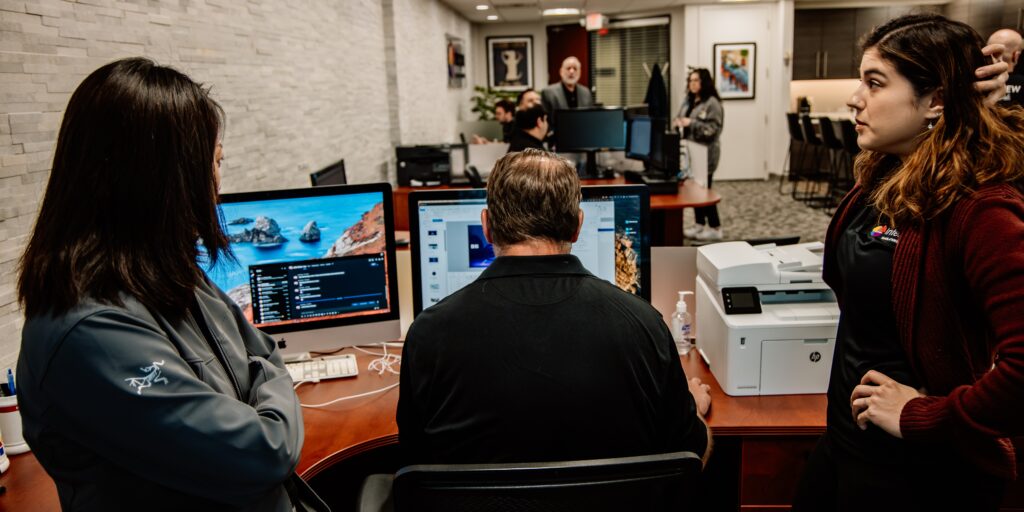
Learn about trends in global instructional design and how to make eLearning culturally relevant for international audiences. We will use learner-centric methodologies and translation and localization for inclusivity and accessibility.
Ever wonder how those online courses manage to keep you glued to the screen, soaking up information like a sponge? It’s all thanks to the magic of instructional design! In today’s fast-paced, interconnected, and globalized world, the art of instructional design isn’t just about slapping together some PowerPoint slides. It’s about crafting immersive and impactful learning experiences that resonate across diverse cultural and linguistic landscapes.
As technology evolves and shapes educational practices, instructional designers must stay abreast of emerging trends. In this blog post, we’ll dive into the ever-evolving world of instructional design and explore how it’s shaking up the global learning scene! We’ll examine how scenario-based learning, storytelling, and learner-centric methodologies revolutionize learning worldwide. Additionally, we’ll dig into the essential role of translation and localization in bridging cultural divides and ensuring inclusive learning experiences for all learners, regardless of their backgrounds.
Topics covered in this article:
- Scenario-Based Learning: Engaging Across Cultures (with best practices)
- Learner-Centric Methodologies: Adapting to Diverse Learner Needs
- Bridging Cultures: Translation and Localization in Instructional Design
- Global Future Trends and Considerations
Scenario-Based Learning: Engaging Across Cultures
Alright, let’s paint a picture. Imagine learning a new concept not through a boring lecture but by diving headfirst into a real-world example. That’s the beauty of scenario-based learning!
But here’s the kicker: things can get tricky when designing scenarios for a global audience. What might seem like a no-brainer in one culture can totally miss the mark in another. A translated joke lands or falls flat. That’s why it’s crucial to do your homework and consult with cultural experts to make sure your scenarios resonate worldwide.
Best practices for translating and localizing scenario-based learning content include:
- Cultural sensitivity training for instructional designers and translators to understand cultural nuances and avoid potential misinterpretations.
- Utilizing culturally diverse teams to review and validate scenario content from different perspectives.
- Incorporating authentic cultural elements and references into scenarios to enhance learner engagement and relevance.
Impact of Storytelling in Learning
Now, let’s talk storytelling. Nope, we’re not tucking you in for bedtime just yet! Storytelling isn’t just for fairytales – it’s a secret weapon in the world of learning, having been a fundamental aspect of human communication since ancient times. It’s in our DNA to pass down knowledge through stories! When it comes to learning, stories aren’t just entertaining – they’re like a magnet for your brain. They grab your attention, tug at your heartstrings, and stick like glue in your memory.
In the context of learning, storytelling is a powerful tool for capturing learners’ attention, enhancing retention, and fostering emotional connections with the content. Stories transcend linguistic and cultural barriers, making them a versatile instructional strategy for diverse global audiences.
When adapting storytelling for diverse linguistic and cultural audiences, it’s essential to consider the following:
- Cultural context: Tailoring stories to reflect cultural values, traditions, and beliefs ensures relevance and resonance with learners from different backgrounds.
- Linguistic nuances: Adapting storytelling techniques to accommodate linguistic variations and idiomatic expressions enhances comprehension and engagement.
- Visual storytelling: Incorporating multimedia elements such as images, videos, and animations enhances the storytelling experience and accommodates diverse learning preferences.
Learner-Centric Methodologies: Adapting to Diverse Learner Needs
Alright, let’s focus on you – the learner. In today’s world, it’s all about you as a eLearning developer, technical writer, or eLearning course manager! And rightfully so. Learner-centric methodologies are like a tailor-made suit for your audience’s brain. They cater to your unique learning style, pace, and interests. But here’s the twist: when you’re designing personalized learning experiences for a global audience, you’ve got to juggle a whole bunch of different balls. It’s like trying to plan a party where everyone’s got different tastes – talk about a challenge! That’s why it’s crucial to serve up a smorgasbord of learning options, from videos to quizzes, to adaptive learning algorithms and microlearning modules; it requires flexibility to keep everyone engaged and included.
While these methodologies offer significant benefits in enhancing learner engagement and outcomes, they also present challenges in translating and localizing the content to accommodate diverse cultural and linguistic backgrounds. So, how do we ensure inclusivity across cultures?
To ensure the inclusivity and effectiveness of learner-centric methodologies across cultures, consider the following tips:
- Multimodal content delivery: Offering instructional content in multiple formats (text, audio, video) accommodates diverse learning preferences and literacy levels.
- Cultural relevance: Integrating culturally relevant examples, case studies, and references into learning materials enhances relevance and resonance with learners from different backgrounds.
- Collaborative learning communities: Facilitating peer-to-peer interaction and collaboration among learners from diverse cultural backgrounds fosters cross-cultural understanding and collaboration.
Bridging Cultures: Translation and Localization in Instructional Design
Now, let’s break down some language barriers. Translation and localization are the unsung heroes of instructional design, especially for eLearning courses. They’re the ones making sure that everyone, from New York to Nairobi, can access the same knowledge. But here’s the thing: translating isn’t just about swapping out words – it’s about capturing the essence of a message and serving it up in a way that makes sense to different cultures. That’s why it’s crucial to have a crack team of translators and cultural experts on board to make sure your message lands loud and clear worldwide.
Best practices for effective translation and localization in instructional design include:
- Contextual translation: Translating content in context to preserve the intended meaning and instructional integrity.
- Cultural adaptation: Adapting instructional content to reflect cultural norms, values, and preferences, and to resonate with diverse audiences.
- Quality assurance: Implementing rigorous quality assurance processes to ensure accuracy, consistency, and cultural acceptability in translated materials.
Global Future Trends and Considerations
Let’s peer into the crystal ball and see what the future holds for instructional design. Spoiler alert: it’s looking pretty darn exciting! We’re talking AI-powered learning platforms, immersive virtual reality experiences, and a whole lot more. But here’s the catch: with great power comes great responsibility. As we dive headfirst into the brave new world of instructional tech, we’ve got to make sure we’re not leaving anyone behind. That means staying on top of the latest trends, keeping our finger on the pulse of global learning needs, and collaborating with experts from all corners of the globe to create a learning landscape that’s culturally diverse, inclusive, accessible, and downright awesome.
Recommendations for staying ahead of the curve and adapting instructional design practices to meet the needs of an increasingly-global audience include:
- Embracing technological advancements: Leveraging AI and machine translation technologies to streamline the translation and localization process and improve efficiency and scalability.
- Continuous learning and adaptation: Staying informed on emerging trends and best practices in instructional design and translation to remain adaptable and responsive to evolving learner needs.
- Collaboration and cultural exchange: Fostering teamwork among instructional designers, translators, and cultural experts from diverse backgrounds to create inclusive and culturally-relevant learning experiences.
Instructional Design is Understanding Your Learners
From scenario-based learning to the power of storytelling, we’ve explored how instructional design is shaping the global learning landscape. But here’s the bottom line: instructional design isn’t just about creating courses – it’s about understanding diverse learners and crafting experiences that speak to them. By embracing evolving trends such as scenario-based learning, storytelling, and learner-centric methodologies, instructional designers can create impactful learning experiences that inspire, engage and empower learners worldwide. Furthermore, integrating translation and localization considerations into instructional design practices is essential for ensuring inclusivity and accessibility for all learners.
Ready to translate a course for a global audience?
- Follow the recommendations under “Global Future Trends and Considerations” to ensure you are continuing to stay on top of instructional design trends.
- When you’re ready to translate, partner with a company that understands your needs to adapt to a culturally diverse audience. Interpro offers complimentary localization consultations to help you create translations for your global audience.
Let’s keep pushing the boundaries, breaking down barriers, and creating a world where knowledge knows no bounds!
Category: Translation
Tags: Guides
Service: eLearning Translation
Industry: Education
Don't forget to share this post!
Stay Updated with Interpro
Subscribe to our newsletter for the latest updates and insights in translation and localization.






